Vinay Kathotia, one of our lecturers in mathematics education, writes about his work with an educational charity in Udaipur.
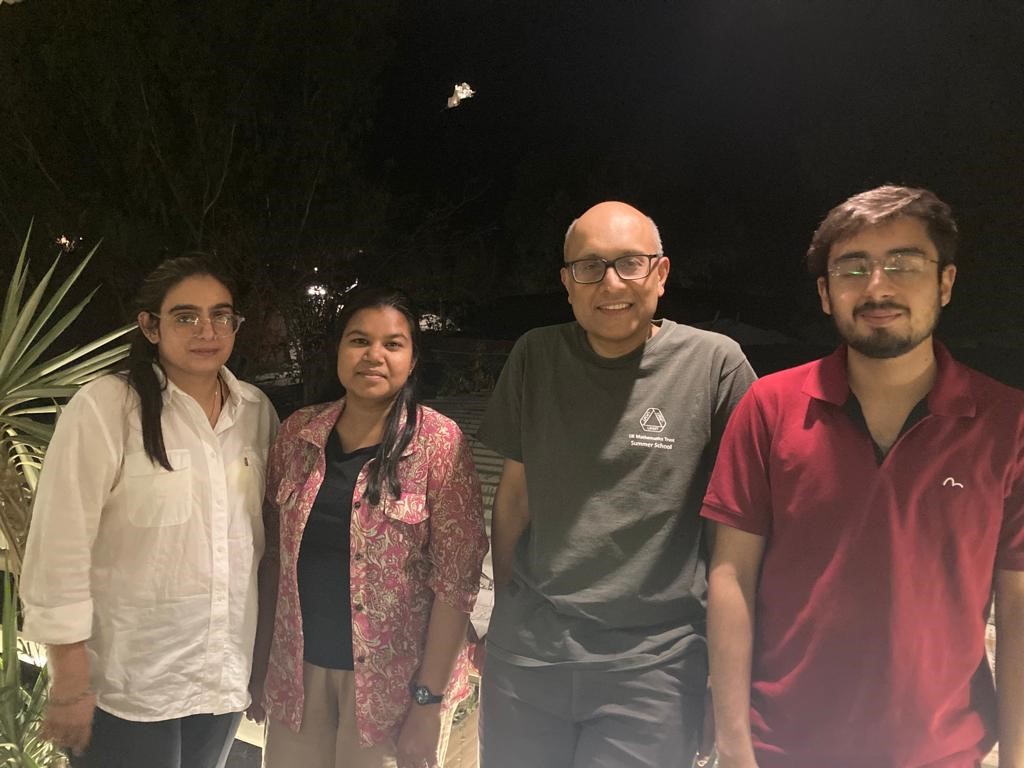
The Shiksha Sambal central maths team with Vinay,
from left: Jyoti, Neha (team lead), Vinay and Ruderaksh
Nestled within the Aravalli hills, one of the oldest mountain ranges in the world, there lies a vivid example of the extremes that exist side by side in India. Udaipur, the City of Lakes in India’s desert land of Rajasthan, has some of the most opulent palaces-turned-into-hotels in India. On the other hand, the neighbouring hills, strip-mined for centuries for zinc, lead, copper and other riches, are home to significant socioeconomic and educational disadvantage. Rural Rajasthan is one of the lowest-ranked regions for student enrolment and mathematics attainment (India’s Annual State of Education Report, 2022, p.67). In particular, there are substantial drops in retention for tribal communities and female students as they transition from primary to upper-secondary education (India’s National Education Policy, 2020, p.25). Rajasthan also ranks lowest on mothers’ schooling, which has an ongoing generational impact.
Working in the midst of this context is a multi-institution educational charity, Vidya Bhawan Society (VBS). VBS was founded in 1931 and has since grown to include an education resource centre, schools, a polytechnic, a rural (undergraduate) institute, teacher training colleges, agricultural and environmental centres. It also runs outreach programmes in the rural and tribal hinterland, aimed at fostering a more equitable society.
Vidya Bhawan’s Shiksha Sambal programme
Since April 2022, I have been collaborating – both online and in person – with the mathematics team of VBS’s Shiksha Sambal (Education Support) fellowship programme. This initiative, targeted at learners in Grades 6-8 (the first three years of secondary school) aims to support language and mathematics education (and some science and co-curricular activities) in a total of ten state schools across five rural and socioeconomically disadvantaged communities around Udaipur. Shiksha Sambal is funded by Hindustan Zinc Limited, a significant local employer and one of the world’s largest miners of zinc and lead, as part of its corporate social responsibility work.
The Shiksha Sambal fellowship programme is delivered by five pairs of ‘fellows’, who are all women and most are recent graduates of a four-year Bachelor of Elementary Education programme from Delhi University. Each pair of fellows (one for language and one for mathematics) is responsible for two schools. The fellows work together, three days per week in each of their two schools, complementing the work of the regular schoolteachers.

Shiksha Sambal fellows working with students in their schools. | Photo Credits: Vidya Bhawan Society
As part of the programme, some of the Grade 8 students also got to attend a residential summer camp at the VBS campus in Udaipur. For many of them it was the first time they had lived away from home. It was also the first time that many of the fellows had lived and worked away from home. Experiences like this can be particularly meaningful in a challenging, rural and patriarchal environment where girls are often kept home for domestic work, and there is prevalence of child marriage – even though it is illegal.
Now entering its second year, the Shiksha Sambal fellowship programme has been transformative for some of the students and for the fellows themselves. You can read more about the experiences of the fellows here.
The Open University’s contribution
My work with Shiksha Sambal has involved supporting the development of mathematics resources and working with the fellows on their professional development, both mathematical and pedagogical.
As part of this work, we have drawn on research in mathematics education, including approaches from Realistic Mathematics Education (RME). In particular:
- grounding mathematics in students’ experiences and contexts relevant and meaningful for them
- reinforcing the role of language and reasoning in mathematics
- using games, craft activities, and visual and hands-on materials.
These approaches were chosen to anchor learning and help the students see and use mathematics as a sense-making and expressive medium. As these approaches have to work for the particular learners and their environment, the collaboration with the fellows has been essential in trialling, adapting and improving the curricular materials and teaching strategies. One key resource for the learners is a workbook, which includes a mix of closed and open-ended mathematical tasks, puzzles, stories providing a narrative for the learning, and opportunities to create their own questions and stories.
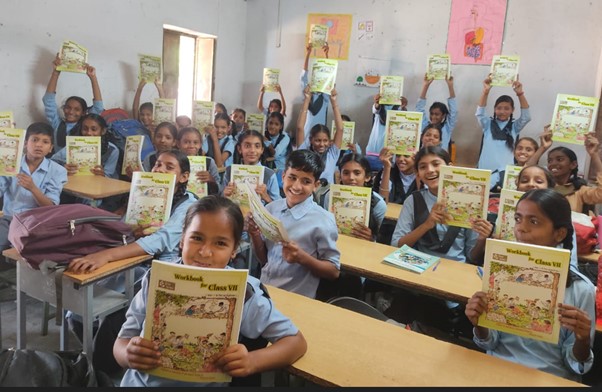
Grade 7 students receiving their new workbooks. | Photo Credit: Vidya Bhawan Society
The first year of the fellowship programme has been full of rich experiences. As with most learning and research, it has led to more questions than answers! My colleagues in India and I are now developing research proposals to explore the exciting practice and emerging ideas, some of which are presented below.
Contrasts and overlaps between language and mathematical learning
The language and mathematics fellows naturally found themselves supporting each other’s activities in the classroom. This highlighted opportunities for joint work which are being integrated in this year’s activities. The language programme also involved songs and silly rhymes, performed as group embodied activities, rich in movement and gesture, which drew together students and fellows. The affective and learning gains of these song-led activities seem substantial. Can we develop similar activities for developing understanding and engagement in mathematics?

Dancing aloud ‘Ram Narayan baja bajata’ (Ram Narayan plays the music) | Photo Credits: Vidya Bhawan Society
Mathematical storytelling
The students’ workbook introduces the ‘Story of Ghanshyam’, a cowherd who develops symbols for counting to keep track of his cows. The story evolves to bring in manipulatives including bundles of sticks and a rudimentary ‘abacus’ (vertical rods which can accommodate nine beads each).
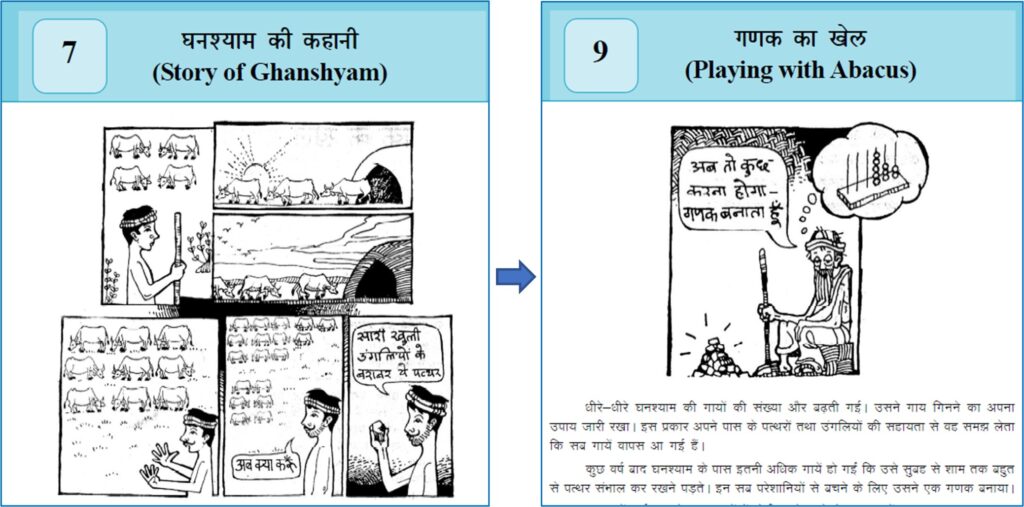
The Story of Ghanshyam: Pages from the Shiksha Sambal Grade 6 workbook | © Vidya Bhawan Society
We saw students using materials such as these and Dienes blocks to ground and enrich their understanding of place value. It was interesting to note that students not only used these materials as originally intended, but also co-opted them in games of their own. These variations need to be investigated further.

Counting sticks and Dienes blocks (used traditionally!) | Photo Credits: Vidya Bhawan Society

Learners extending their use of Dienes blocks | Photo Credits: Vidya Bhawan Society
Few of the students have books at home, so VBS runs a mobile library to support students. The students’ engagement with mathematical stories, games and manipulatives could point towards introducing mathematical materials and games into the mobile library, in a similar way to UK programmes such as the Letterbox Club.
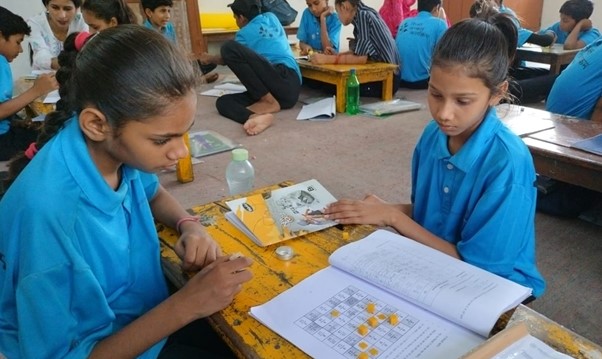
Games that bring together dice, fractions, factors and multiples, and strategising (getting four counters in a line) | Photo Credit: Vidya Bhawan Society
Crafting mathematics
Alongside curricular work, students worked on a mix of puzzles and craft activities, including tangrams, modular origami and mobile origami, and this gave rise to engaging and natural contexts for geometry work. While some students were much engaged and enthused with these activities, others were frustrated when their constructions didn’t quite come together and didn’t have a positive or enabling experience. Some of the issues related to being able to fold accurately, the relevance of precise measurements, and being able to follow complex live or diagrammatic instructions. All of this may need careful unpicking. There may also be more fundamental issues at play here. Gandhi’s ‘Basic Education’ movement, which has craft as a basis for life-long learning, has never sat comfortably with traditional schooling.
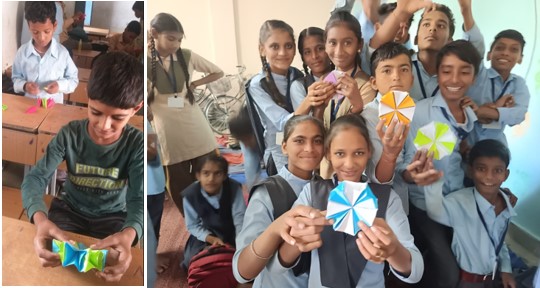
Students constructing and sharing their rotating octagonal modular origami flowers | Photo Credits: Vidya Bhawan Society
Expressive and contextual mathematics
One of the problems that fellows and Grade 8 students worked on was Dragon-kali (originally, The sword of knowledge at www.mathfair.com/some-typical-projects.html)
“The dragon of ignorance has three heads and three tails. However, you can slay it with the sword of knowledge by cutting off all its heads and tails. With one swipe of the sword you can cut off one head, two heads, one tail, or two tails.
But . . .
When you cut off one head, a new one grows in its place.
When you cut off one tail, two new tails replace it.
When you cut off two tails, one new head grows.
When you chop off two heads, nothing grows.
Help the world by slaying the dragon of ignorance.”
Fellows and students were also asked to devise their own similar problem and it was heartening to see their engagement. In their solutions, some used numbers, trial and improvement, symbols, or elaborate drawings, while others used pencils and erasers as part of physical enactments. Many learners were happy engaging with the challenge of devising their own problem, and some went on to develop their scenarios in some depth, naming their monsters, creating related imagery, and clarifying what mathematical principles they were using.
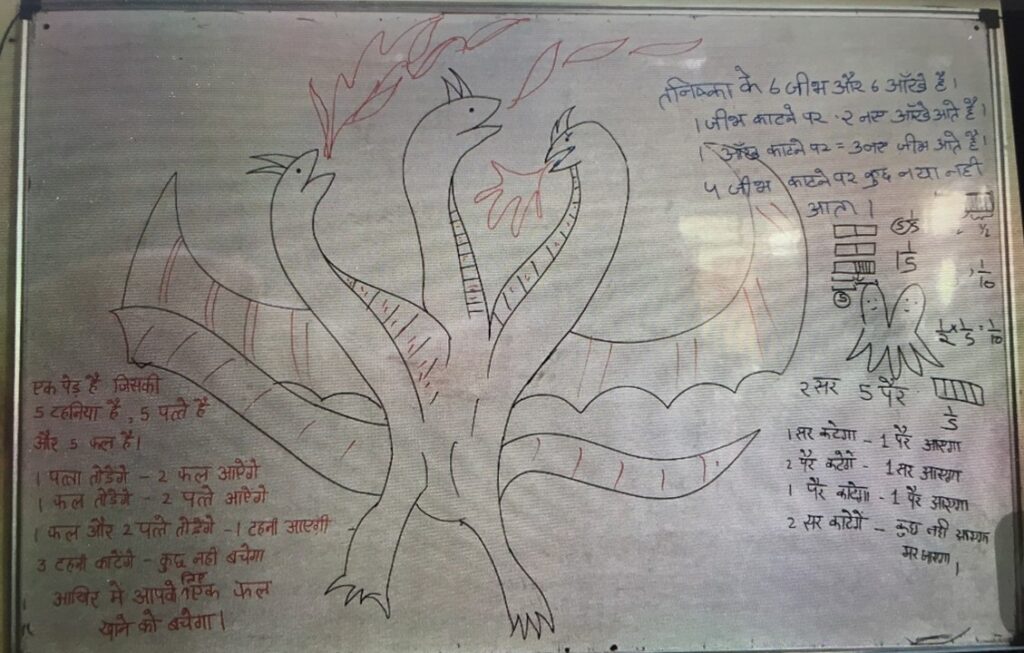
Three variants on the Dragon-kali problem
What supports or inhibits learners using mathematics and language expressively, and the variation across types of problems, contexts, students and groups is something that needs further study.
Navigating the classroom: practical barriers and stories of progress
The fellows had to grapple with a range of practical issues in their classrooms, schools and communities. Support from the existing school staff was variable. The staff were also under pressure to cover the necessary curriculum for the periodic assessments run by the state and for the final Grade 10 assessment which (as in England) serves as a gatekeeper for professions such as nursing or teaching. Fellows were sometimes asked, often with limited notice, to replace their work with assessment related ‘revision’. Some teachers and students saw the work with the fellows as recreation and not actual teaching and learning. Also, the requirement for using standard algorithms in the assessment limited work with sense-making approaches such as grid multiplication or ratio tables.
One of the most challenging aspects was the diversity of attainment and attitudes in their classes, including some students with severe learning needs but with no related diagnoses or support. Additionally, a few male students could be rude or dismissive towards the female fellows on occasion.
Nonetheless, the programme gave rise to a number of heartening successes. As fellows were living locally, they were able to visit the students’ villages and homes, better understand the local context and some of the underlying reasons for poor engagement and behaviour. Supported by this knowledge, a compassionate approach and, where feasible, collaboration with families, the fellows were able to develop and sustain strong and positive relationships with a number of vulnerable, unengaged or challenging students, and significantly improve their participation, behaviour and learning. Below are images of evolving work of one student who initially neither spoke, nor was able to read or write.
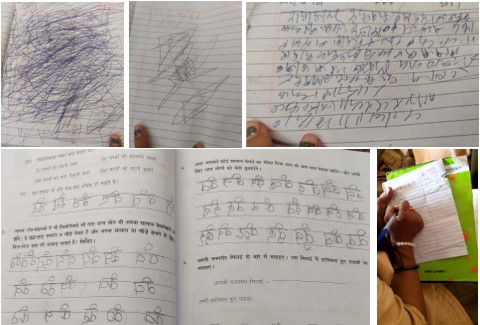
A learning journey| Photo Credits: Vidya Bhawan Society
The fellow who took this student under her wing learned that she had substantial learning needs, had been married early, and did most of the housework before and after school. Over a few months, through steady support, the student moved from scrawling over books, to making letter-like shapes, to being able to recognise and write particular letters and speak some words.
The fellows became role models, not only for all the students in their classrooms but for each other and for the VBS team and the wider community. An open question is now how these successes and the attendant community engagement might be strengthened, replicated, and sustained.
Looking forward
The work and development of the Shiksha Sambal fellows and their students has been uplifting and inspiring. I am looking forward to continuing to support their work and, with them, investigating some of these questions. Do get in touch if you have any thoughts, questions or suggestions – we would love to hear from you.
